

Danish language. Danish (dansk pronounced [d̥anˀsɡ̊] ( ); dansk sprog, [ˈd̥anˀsɡ̊ ˈsb̥ʁɔʊ̯ˀ]) is a North Germanic language spoken by around six million people, principally in Denmark and in the region of Southern Schleswig in northern Germany, where it holds minority language status.[3] There are also significant Danish-speaking communities in the United States, Canada, Brazil and Argentina. Due to immigration and language shift in urban areas, around 15-20% of the population of Greenland speaks Danish as their home language. Danish is largely mutually intelligible with Norwegian and Swedish. Proficient speakers of any of the three languages can understand the others, though studies have shown that speakers of Norwegian generally understand both Danish and Swedish far better than Swedes or Danes understand each other. Both Swedes and Danes also understand Norwegian better than they understand each other's languages.[4] History[edit]
Norwegian language. Norwegian (norsk) is a North Germanic language spoken primarily in Norway, where it is the official language.

Together with Swedish and Danish, Norwegian forms a continuum of more or less mutually intelligible local and regional variants. These Scandinavian languages together with the Faroese language and Icelandic language, as well as some extinct languages, constitute the North Germanic languages (also called Scandinavian languages). Faroese and Icelandic are hardly mutually intelligible with Norwegian in their spoken form because continental Scandinavian has diverged from them. As established by law and governmental policy, there are two official forms of written Norwegian – Bokmål (literally "book tongue") and Nynorsk (literally "new Norwegian"). Finnish language. Old Gutnish. The approximate extent of Old Norse and related languages in the early 10th century: Old West Norse dialect Old East Norse dialect Old Gutnish Old Gutnish was the dialect of Old Norse that was spoken on the Baltic island of Gotland.
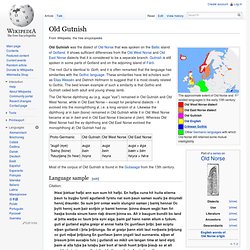
It shows sufficient differences from the Old West Norse and Old East Norse dialects that it is considered to be a separate branch. The root Gut is identical to Goth, and it is often remarked that the language has similarities with the Gothic language. The Old Norse diphthong au (e.g. auga "eye") remained in Old Gutnish and Old West Norse, while in Old East Norse – except for peripheral dialects – it evolved into the monophthong ǿ, i.e. a long version of ø. Standard Swedish. Standard Swedish (standardsvenska, rikssvenska) denotes Swedish as a spoken and written standard language.
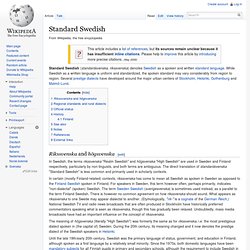
While Swedish as a written language is uniform and standardized, the spoken standard may vary considerably from region to region. Several prestige dialects have developed around the major urban centers of Stockholm, Helsinki, Gothenburg and Malmö-Lund. Scanian dialects. Scanian ( spann / spand, "bucket", hinkmölla / mølle (also kværn), "mill", (väder-)kvarnbränne / brænde, "wood" (to burn), vedvisping / hvepse, "wasp", getingromma/ramme, träffa/træffe (ett/et mål), "hit" (a target)skoband / snørebånd, "shoelace"/"shoestring", skosnörealika/"allike", kaja/kaje, "jackdaw" / "daw" (bird)rabbemos, rotmos /rodmos, a dish (like mashed potatoes, but with other vegetables)grishals/grisehals, karré/karré, a certain kind of pork meat (and dish) Note that letters "Ä", "ä" equal "Æ", "æ" and "Ö", "ö" equal "Ø", "ø" and that Danish spellings "hv..
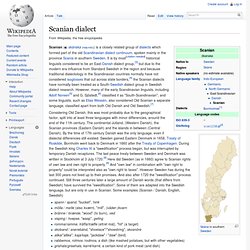
" and "..nd.. " are (almost) equal to "v.. " and "..nn.. " in pronunciation. Typical Scanian words which are not in use in either Swedish or Danish include: upplänning, ---, a person from north of Scania (from any "unknown" province; neighbouring provinces may be excluded; in Swedish the same word means a person from the province of Uppland only) Status[edit] History[edit] Language politics[edit] Historic shifts[edit] Today[edit] North Germanic languages. The North Germanic languages make up one of the three branches of the Germanic languages, a sub-family of the Indo-European languages, along with the West Germanic languages and the extinct East Germanic languages.
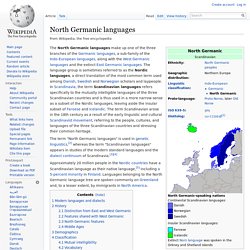
The language group is sometimes referred to as the Nordic languages, a direct translation of the most common term used among Danish, Swedish and Norwegian scholars and laypeople. In Scandinavia, the term Scandinavian languages refers specifically to the mutually intelligible languages of the three Scandinavian countries and is thus used in a more narrow sense as a subset of the Nordic languages, leaving aside the insular subset of Faroese and Icelandic. The term Scandinavian arose in the 18th century as a result of the early linguistic and cultural Scandinavist movement, referring to the people, cultures, and languages of the three Scandinavian countries and stressing their common heritage.
Sje-sound. The sound is transcribed ⟨ɧ⟩ in the International Phonetic Alphabet.
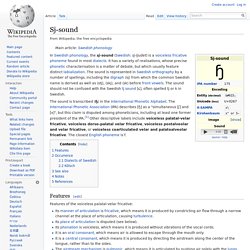
The International Phonetic Association (IPA) describes [ɧ] as a "simultaneous [ʃ] and [x]", but this claim is disputed among phoneticians, including at least one former president of the IPA.[1] Other descriptive labels include voiceless palatal-velar fricative, voiceless dorso-palatal velar fricative, voiceless postalveolar and velar fricative, or voiceless coarticulated velar and palatoalveolar fricative. The closest English phoneme is f. Features[edit] Features of the voiceless palatal-velar fricative: Occurrence[edit]
Swedish language. Swedish ( svenska ) is a North Germanic language, spoken by approximately 8.7 million people worldwide,[1] predominantly in Sweden and parts of Finland, where it has equal legal standing with Finnish.

It is largely mutually intelligible with Norwegian and Danish (see Classification). Old Norse. Old Norse is a North Germanic language that was spoken by inhabitants of Scandinavia and inhabitants of their overseas settlements during the Viking Age, until about 1300.
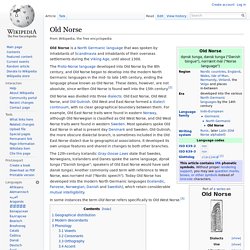
The Proto-Norse language developed into Old Norse by the 8th century, and Old Norse began to develop into the modern North Germanic languages in the mid- to late 14th century, ending the language phase known as Old Norse. These dates, however, are not absolute, since written Old Norse is found well into the 15th century.[2]